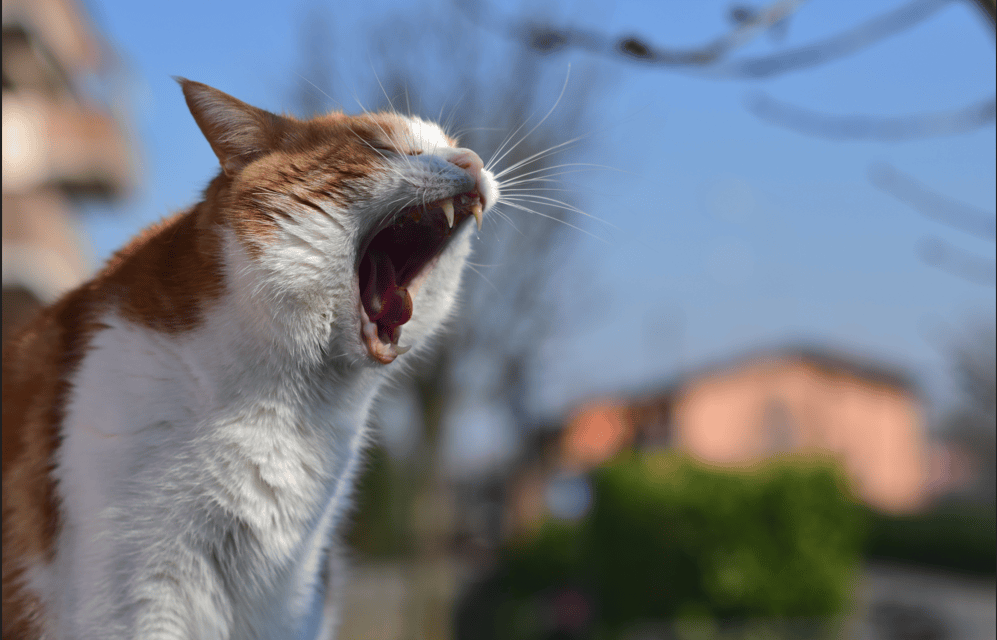Most of us love our feline friends for their elegance, independence, and occasionally mysterious behaviour. But there’s one sound that can abruptly turn a cosy cuddle session into an uncomfortable one: growling. Yes, cats growl. It’s a sound you may be more likely to associate with dogs, but when your cat lets out a low, rumbling growl, it can be pretty serious. If you’re a veteran cat parent or new to cat care, understanding when and why your cat growls is essential for fostering a happy and stress-free environment. Let’s discuss cat growling in detail.
Understanding Cat Growling
Excessive cat growling is a deep, guttural noise that isn’t as loud as a child’s soft voice. It may even presage hissing, swatting, or biting. Unlike purring, which is soothing and vibratory, growling has a sharper edge. It may sound like a low growl or a series of short bursts, depending on the cat’s mood and the circumstances. You might see your cat’s eyes close or the ears flatten back as the fur ruffles when they growl. These little clues are signals that your cat may not be in a good mood.
Is Growling Normal in Cats?
Oh, yes, cat growling is a natural part of a cat’s vocalisation repertoire. Although not as prevalent as meowing or purring, growling is an effective signal for communicating a variety of messages, primarily to express frustration, fear, pain, or a territorial challenge. It’s pretty much your cat telling you to get out of its face or that it’s uneasy.
Difference between Growl, Hiss, Meow
Knowing the distinctions between growling, hissing, and meowing is essential to identifying and understanding your cat’s emotions. In any case, meowing is typically a sound reserved for when your kitten wants to communicate with you. It seems to stop quickly if another cat is the intended recipient of the communication. The way your cat says, “Feed me,” “Pet me,” or “Where have you been all day?” It can run the gamut from just a little chirping to full-on screeching, but it is generally harmless.
Gnashing, to the contrary, is louder. It’s a throaty, deep sound that’s usually accompanied by a physical point or two: Your hunched body, arched back, or even paw swipe. A cat growling signifies that the cat is in self-defence mode and doesn’t want to be messed with.
Hissing is much better than growling. It’s that sharp, abrupt sound, made with an open mouth, usually with the teeth bared. Hissing indicates that danger is near, be it that your cat feels threatened, cornered, or overstimulated.
Consider these sounds part of a cat’s warning system:
Meow: Basic communication
Growl: Back off, I’m uncomfortable
Hiss: Warning and preparation for attack
Common Causes of Cat Growling
Territorial Behavior
Cats are famously territorial. Unlike dogs, which tend to welcome new pack members, cats are territorial and need time to claim their space and defend it with every fibre of their being. Whether it’s a sunny windowsill, your favourite chair, or even you, cats can be possessive of their owners. Growling means, “This is mine, stay away.”
To manage territorial growling:
Respect their space. Don’t force interactions.
Try the scent swapping when you’re introducing new pets.
Keep routines consistent. Changes can unsettle them quickly.
Territoriality is a natural part of the canine condition, but understanding how to manage it can help prevent growling.
Pain or Illness
Cats are experts at concealing pain. In the wild, demonstrating vulnerability might make them prey for predators, and domestic cats bring this instinct to the table. A cat growling can sometimes be one of the few physical signs that something is amiss. If your cat was not a cat who had previously growled when you pick them up or touch a particular area, and all of a sudden begins to growl, then pain may be the reason.
Several medical conditions can cause a cat to growl:
Arthritis or other problems with the joints (particularly in older cats)
Dental disease causes mouth pain
Urinary tract infections, causing painful urination
Gastrointestinal issues, such as constipation or bloating
Wounds, sprains, or abscesses
Fear and Anxiety
Think: someone twice your size abruptly picking you up or a loud vacuum in the vicinity. That’s the feline world. A cat growling is a common reaction when fear starts to set in. Cats growl lowly, in stark contrast to barking dogs, but no less of an expression of intensity.
Fear-based growls also occur when:
Loud noises (construction, fireworks, thunder)
Strangers or unfamiliar scents
Sudden movements
Confined spaces or feeling trapped
Aggression or Defensive Reaction
Not all cat growling is about fear; some cats growl because they want to engage in a fight. Aggressive, predatory growling is fiercer and often leads to swiping, biting, or launching attacks.
Aggressive growling may come from:
Social conflicts with other pets
Protecting kittens
Unprovoked attacks during play
Redirected aggression (Your cat spots another cat outside, but strikes you)
Overstimulation During Petting
One minute, your cat is purring in your lap, and the next, they’re growling there while you pet them. This sudden change can be a petting-induced aggression, a familiar yet perplexing behaviour for cat parents. A few cats prefer brief strokes of petting, but excessive petting can be overstimulating.
When overstimulated, a cat may:
Flick their tail rapidly
Flatten their ears
Stop purring suddenly
Tense their body
Growl or swat without warning
Cat Growling and Their Body Language
Ears, Eyes, and Tail Signals
Your cat has a lot to say without ever speaking a word. When it comes to putting us on blast, their ears, eyes, and tail are usually saying it long before the actual growl sound comes out of their mouth. By recognising these cues, you can avoid stress and respond appropriately.
Ears:
Flattened toward the back: Either fear or aggression
Twitching: Irritation or overstimulation
Forward: Alert and curious
Eyes:
Dilated pupil: Fear, excitation, or irritation
Slow blinking: Calm and trusting
Stare with wide open eyes: Defensive or aggressive stance
Tail:
Twitching tip: Agitation
Ruffled: On high alert or afraid
If your cat is making these silent but violent moves and growling, they feels threatened. With your new understanding of how to spot these cues, you’re ahead of the game in diffusing the situation before it becomes a problem.
Common Cat Growling Triggers by Situation
New Pets or People
There’s no bigger cat world disruption than a new creature infiltrating its territory. Cats are creatures of habit and do best in an environment that offers consistency. A cat growling can be its way of saying it’s confused, stressed, or on the defensive when a new pet or person invades its space.
Here’s what might trigger it:
A new cat or dog in the home
A strange or infant’s body ponders, or are more common people moving? That’s how your cat feels about the vet.
A cat growling during these activities may indicate that:
Motion sickness
Fear of confinement
Pain during physical exams
Other stressed animals nearby
Some cats will even defensively growl at the sight of a carrier. It’s crucial to begin career training when the dog is young, turning this space into a safe room and not a prison box.
Try these tips:
Train at home. Leave the carrier at home often.
Add familiar-smelling blankets and treats.
Work up to short car rides with a reward afterwards.
If there are growls at vet visits, there’s nothing wrong with asking for cat-friendly vets who know how to minimise stress levels. Some even offer mobile services, which can be a great boon.
Resource Guarding (Food, Toys, Territory)
That is, cats can be protective of resources, just like dogs. That includes food bowls, favourite toys, scratching posts, and you. A cat growling over food or toys is a classic sign of resource guarding, defensive behaviour intended to protect against losing something valuable.
You might notice:
Snarling when another dog comes near at feeding time
Swatting someone when playing with a favourite toy
Preventing access to litter boxes or resting areas
Becoming possessive over human attention
Insecurity is a big reason that they behave this way. Cats that have experienced competition for food or supplies may be more susceptible to this.
To reduce growling from guarding:
Feed cats individually to prevent fighting
Cycle regular toys so one is not so heavily protected
Offer more than one location to eat, sleep or scratch.
Helping your cat become more comfortable in their surroundings can go a long way in reducing this type of defensive growling.
Conclusion
Cat growling is no exception to this rule: When a cat growls, even cat owners who haven’t heard it before can tell something’s wrong. It’s your cat’s way of signalling something is wrong, whether that means they have fears, are in pain, or are getting frustrated. Sometimes it means their feelings about a person, place, or thing are ambiguous. Do not respond with anger or confusion; react with curiosity and caring. Observe their body language and listen to the tones of their voice, and most importantly, give them their space.
FAQs
Is it a bad sign when a cat growls?
Yes, growling can be an indication of a serious medical or behavioural concern. Always work it up with concern, particularly if it is sudden or associated with other symptoms.
Is It Possible To Train My Kitten Not To Growl?
You can’t eliminate growling completely, but you can work to curb it by addressing the underlying causes of your cat’s aggression.
Why does my cat growl when I touch them?
I guess a bit overstimulated or ticklish in a few places. Watch for their body language and only pet them where they’re receptive.
Is it okay to make your cat growl?
Never. Punishment erodes trust and may promote aggression. Redirect, space and quiet affection, instead.
Are there some breeds that growl more than others?
Some breeds, such as Bengals, Siamese and Sphynx, are noisier and more expressive than others, and this can feature growling.





